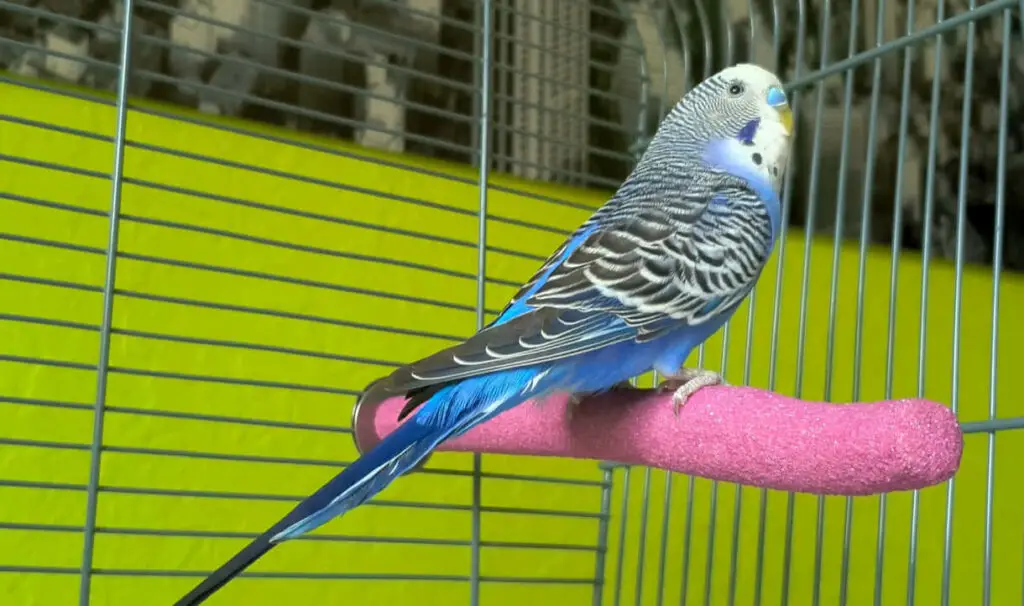Budgies, those colorful and charismatic feathered friends, have long graced our homes with their cheerful presence. Yet, beneath their vibrant plumage lies a world of complexity and vulnerability. Tumors in budgies, though often overlooked, are a significant concern for these beloved avian companions. In this comprehensive exploration, we aim to shed light on the enigmatic realm of budgie health, focusing on the types, signs, and potential solutions for tumors in these pint-sized parakeets.
So, prepare to embark on a journey into the intricacies of budgerigar well-being, armed with the knowledge you need to ensure a happy and healthy life for your avian companion.

Contents
What are Tumors in Budgies?
Tumors in budgies refer to abnormal, uncontrolled growths of cells within a budgerigar’s body. These cellular anomalies can materialize as discernible lumps or masses, disrupting the normal tissue architecture. Importantly, they come in two primary forms. The 1st is benign, which is non-cancerous and typically less aggressive. The 2nd is malignant, which is cancerous and can potentially infiltrate adjacent tissues and metastasize to distant parts of the body. These tumors have the potential to arise in a range of anatomical locations within the budgie, including skin, internal organs like the liver or kidneys, and the reproductive system, posing varying degrees of threat to the bird’s health and well-being.
Types of Tumors in Budgies
Before delving into the specifics of tumors in budgies, it is important to understand that these growths can be classified into two main categories: benign and malignant.
Benign Tumors
- Lipomas: Lipomas are non-cancerous fatty tumors that can develop under the skin or in the abdominal region of budgies. While they are usually harmless, they can become problematic if they grow too large, causing discomfort or impeding movement.
- Papillomas: Papillomas are benign growths that can occur in various parts of a budgie’s body, including the mouth, throat, or digestive tract. They are typically characterized by a wart-like appearance.
- Fibromas: Fibromas are benign tumors that primarily affect the skin and are composed of fibrous tissue. They can manifest as small lumps or growths on the budgie’s body.
Malignant Tumors
- Adenocarcinomas: Adenocarcinomas are malignant tumors that often affect the budgie’s internal organs, such as the liver, kidneys, or reproductive system. They tend to grow rapidly and can be life-threatening.
- Sarcomas: Sarcomas are aggressive tumors that originate from connective tissues, muscles, or bones. They can occur in various parts of the budgie’s body and tend to invade neighboring tissues.
- Lymphomas: Lymphomas, also known as lymphatic cancer, involve the lymphatic system and can spread to different organs in the budgie’s body. They are often challenging to treat.

Symptoms and Signs of Tumors in Budgies
Recognizing the symptoms and signs of tumors in budgies is crucial for early detection and intervention.
1. Behavioral Changes: Budgies with tumors may exhibit changes in behavior, such as increased lethargy, irritability, or a decrease in playful activities. They may also isolate themselves from other birds or humans.
2. Physical Symptoms:
- Lumps or Masses: The most obvious sign of a tumor in a budgie is the presence of a lump or mass on or under the skin. These growths can vary in size and location.
- Changes in Feather Condition: Tumors can affect the bird’s ability to preen and maintain its feathers. As a result, you may notice disheveled plumage, ruffled feathers, or bald patches.
- Difficulty Breathing or Eating: Tumors located in the throat or digestive tract can cause difficulty in swallowing or breathing. Budgies may show signs of discomfort while eating or drinking.
- Weakness and Lethargy: Budgies with tumors often become weak and lethargic due to the energy expended by their bodies in fighting the disease.
Causes and Risk Factors Leading to Tumors in Budgies
Understanding the causes and risk factors associated with tumors in budgies is crucial for their prevention and management.
- Genetic Predisposition: Genetics can play a role in a budgie’s susceptibility to tumors. Some budgie strains may be more prone to developing specific types of tumors due to their genetic makeup.
- Environmental Factors: Budgies exposed to certain environmental toxins, including pesticides, heavy metals, and tobacco smoke, may have an increased risk of tumor development.
- Age: Like many animals, budgies are more susceptible to tumors as they age. Older budgies are at a higher risk compared to young ones.
- Diet and Nutrition: Poor nutrition can weaken a budgie’s immune system, making it more susceptible to health problems, including tumors. A well-balanced diet is essential for overall budgie health.
- Hormonal Factors: Hormonal imbalances, often related to reproductive issues in female budgies, can contribute to the development of certain tumors.

Considerable Treatment Options when Budgies Have Tumors
The choice of treatment for tumors in budgies depends on various factors, including the type of tumor, its size, and the budgie’s overall health.
A. Surgery: Surgical removal of the tumor is a common treatment for both benign and some malignant tumors. This approach is often effective if the tumor is accessible and hasn’t metastasized.
B. Radiation Therapy: In cases where surgery isn’t possible or if the tumor is widespread, radiation therapy may be employed to shrink or slow down tumor growth.
C. Chemotherapy: Chemotherapy drugs can be used to treat certain types of malignant tumors. However, this treatment option may have side effects and isn’t suitable for all budgies.
D. Palliative Care: For budgies with advanced or inoperable tumors, palliative care focuses on improving the bird’s quality of life and managing pain and discomfort.
E. Supportive Care: Regardless of the chosen treatment, supportive care, including proper nutrition and a stress-free environment, is essential to help the budgie cope with the effects of the tumor and treatment.
How to Prevent Budgies from Tumors
Preventing tumors in budgies involves a combination of proactive measures to minimize risk factors and ensure their overall well-being. While not all cases of tumors can be prevented, these strategies can help reduce the likelihood of tumor development:
Nutritious Diet: Offer a balanced diet with fresh foods and avoid fatty or processed options.
- Clean Environment: Keep their cage and surroundings clean and toxin-free.
- Vet Visits: Regularly visit an avian vet for check-ups.
- Genetic Considerations: When breeding, select pairs with a healthy genetic history.
- Stress Management: Provide a stable, stress-free environment with toys and activities.
- Exercise: Encourage physical activity and mental stimulation.
- Quarantine New Birds: Quarantine new budgies to prevent disease transmission.
- Pesticide Awareness: Ensure plants and surroundings are pesticide-free.
- Early Detection: Be vigilant for any unusual changes in behavior or health.
Remember, while prevention helps, some factors are beyond control, so attentive care is key to budgie well-being.
Conclusion
In conclusion, our exploration of tumors in budgies equips us with essential knowledge for responsible and empathetic caregiving. Whether benign or malignant, these growths can affect our cherished feathered companions. By understanding their types, causes, symptoms, and available treatments, we empower ourselves to act decisively and seek early intervention when needed. Prevention strategies, like providing a nourishing diet, maintaining a clean environment, and scheduling regular veterinary check-ups, play a pivotal role in safeguarding our budgies’ health.
Remember, the bond we share with our budgies is a precious one, and by staying informed and proactive, we can ensure their well-being and continue to enjoy the colorful, melodious presence they bring into our lives.

